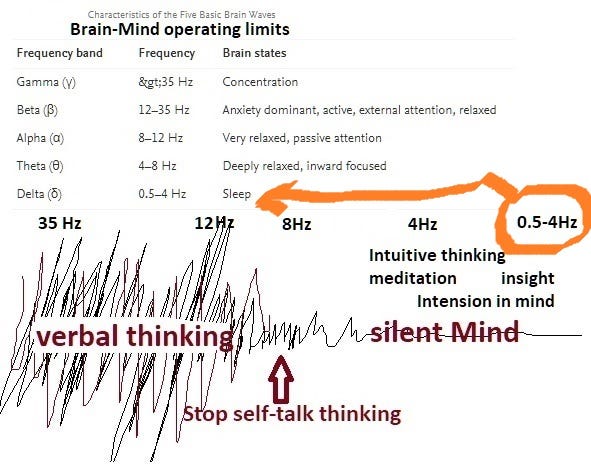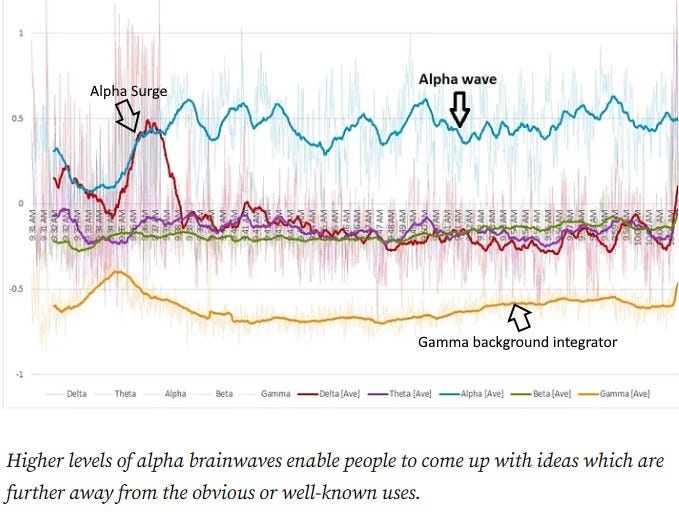
In our daily lives, we move between mind spaces without even noticing. The difference between a restless, fragmented mind and a silent, coherent one is not only psychological — it is vibrational.
When you scroll through TikTok or lose yourself in a rhythm, your brain often operates around eight hertz. This is the alpha range, a frequency of quiet engagement. It is not yet meditation, but it is the prelude to it — a baseline of presence. At this point, the sense of “now” begins to stabilise. The world seems immediate, light, and somewhat effortless.
Go deeper, and the frequency slows to around four hertz. Thought no longer moves as it did before. The self begins to lose its edges. In Buddhist terms, this is the cusp of Śūnyatā — emptiness, where perception remains but identity begins to dissolve.
Below four hertz, the mind disappears altogether. This is the threshold where you fall into sleep or deep unconsciousness. Dreams arise here not from clarity but from the nervous system trying to maintain coherence — bursts of sleep spindles and replays that mirror life but without awareness.
Yet if you remain awake while moving through this threshold, something remarkable happens. Awareness begins to perceive itself. Time loosens. The boundary between observer and observed fades, and what is left is a silent witnessing — a pure, open field.
Between eight and four hertz lies a narrow bridge. It is here that the ordinary mind yields to the deeper field. The surface of thought ripples, then stills, and the faint vibration of the universe begins to echo through awareness. Every insight, every moment of realisation, is born here — in this subtle transition between movement and stillness. The ancients called it the door of knowing.
Stay here long enough, and perception changes texture. The world no longer appears as a collection of separate things. Instead, it unfolds as one living pattern — self-organising, breathing, aware. You begin to see that reality is not composed of matter alone but of rhythm, density, and relationship.
When you return upward through the frequencies, you bring something back. Not a memory but a re-ordering. The field of silence has touched the mind, and thought now carries a different quality. It becomes lighter, more transparent, closer to the truth of things. Creation flows easily. Words and actions begin to mirror the stillness they emerged from.

This is how deep meditation changes life without effort. The deeper spaces reorganise the surface. The tangible reshapes itself around the intangible, as if the universe responds to coherence with coherence.
Most modern commentaries on attention and consciousness overlook these mind spaces. They describe the measurable — behaviour, dopamine, productivity — but miss the geometry of awareness itself. To speak only of tangibles is to describe the waves while ignoring the sea.
The mind is not a fixed organ but a living field that spans frequencies. The eight-hertz state is where you live; the four-hertz cusp is where you transform; below that lies the invisible source of all mind. When all three are sensed at once, you begin to experience wholeness — the synchronisation of all frequencies into a single hum of being.
And when the hum becomes silence, there is nothing more to add.
Postscript — The Cleansing of the Higher Frequencies
What happens when the mind rises back from silence is more than relaxation; it is re-ordering. This observation arises from both neuroscience and contemplative phenomenology — two lenses that are finally beginning to meet. When the mind descends into slower frequencies, from beta down to alpha, theta, and sometimes delta, the networks that sustain thought, identity, and sensory processing begin to quieten. The familiar hum of self fades, and what remains is a broad synchrony of awareness.
In this descent, the default mode network and the salience network — those responsible for self-referential thought and emotional relevance — drop away. Meanwhile, the thalamus and cortical midline structures begin to synchronise at lower frequencies, re-tuning the entire field.
When awareness rises back from these depths, the “frontline” systems — the cognitive and sensory networks operating at higher frequencies — do not resume in the same scattered pattern. They come back coherently phased with the slower oscillations. What returns is not the same mind that went down, but one cleansed by alignment.
In spiritual terms, this has always been called purification. In physiological terms, it is the re-synchronisation of fast cortical oscillations with the slow, global ones. The deeper field acts like a tuning fork, resonating through the layers of mind. Each descent into stillness resets the system, and each return carries the signature of coherence.
This is the true meaning of cleansing — not a moral act, but a natural recalibration of consciousness itself.

